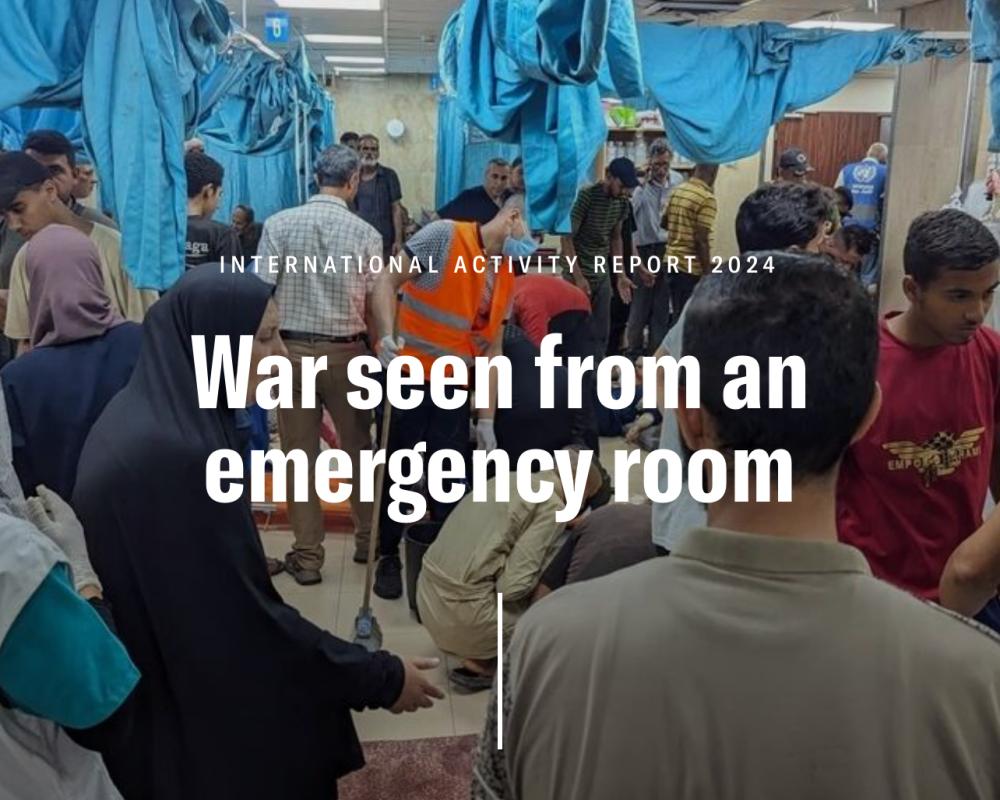
I was working as an emergency doctor for Médecins Sans Frontières (MSF) in the emergency department of Al-Aqsa hospital, Deir Al-Balah, Gaza, Palestine, when two young girls were brought in, one about seven years old, the other five. The older one had lost her left arm from the shoulder. The younger one was covered in blood, but I couldn’t immediately identify her injury, so I focused on her.
At first, I was hopeful, because she was on her back, and I couldn’t see any signs of injuries. I thought that the blood belonged to her sister. But when I turned her over, her entire right side was open. Her lungs were exposed, covered in shrapnel and dirt, moving fast with her breathing.
I knew there was no cardiothoracic surgeon at the hospital. Even if there had been, I knew her chances were slim. I tried to stop the bleeding, packed the wound and brought her to the paediatric surgeons. When she came out, I took her to the intensive care unit and stayed with her, adjusting her medications and monitoring her condition, hoping she would make it. One of my colleagues tried to prepare me emotionally, because he knew it was unlikely she would.
Indeed, some hours later, my colleague woke me up. The girl had not survived the night.
One of my colleagues tried to prepare me emotionally, because he knew it was unlikely she would. Indeed, some hours later, my colleague woke me up. The girl had not survived the night.
Subsequently, I learned that she and her sister had been fleeing from northern Gaza with their father, mother, and brother when an airstrike hit their car. Most of the family were killed instantly.
The number of people injured or killed, and the nature of their wounds, are beyond what any emergency response can manage. Not a single hospital is fully functioning. Every week – sometimes every day – hospitals receive dozens, even hundreds, of patients in the space of a few minutes, with deadly or life-altering injuries from Israeli airstrikes, bombardments, artillery shelling, and high-impact explosives, including severe burns, crush injuries from being trapped under collapsed buildings, and severed limbs.
As a medical student in Gaza in 2018, I witnessed the Great March of Return, when protests held at the border of the enclave were met with hails of gunfire from Israeli forces. More than 7,900 people were shot with live ammunition between March 2018 and November 2019, according to the Ministry of Health. By the end of December 2019, MSF had treated over 900 patients with gunshot wounds. At the time, MSF staff faced major challenges: not only the complexity of the injuries, but also the lack of expertise in treating them, the limited medical supplies, and the absence of proper testing to guide treatment for the high rates of infection that occurred.
Today, it’s even worse. Compared to every war we have previously lived through, the devastation of this one has been beyond words. In Gaza, we have always struggled with shortages of medical supplies, but now they are practically non-existent. I don’t think I have ever experienced such a feeling of despair, knowing we could save lives if only we had enough supplies.
We do what we can, knowing it’s never enough. Every day, we are forced to make impossible decisions and see patients we cannot save.
I don’t think I have ever experienced such a feeling of despair, knowing we could save lives if only we had enough supplies.
Beyond the emergency response, we see a shocking number of people with wounds, burns, and other injuries that require long-term, complex care. In addition to high-level surgery, many need treatment for chronic, antibiotic-resistant infections, physiotherapy, regular check-ups, and mental health support, as well as practical assistance. However, even providing a wheelchair or a latrine becomes pointless if the roads are blocked by rubble or sand. How can people navigate this destruction?
Long-term rehabilitation requires infrastructure, expertise, and coordinated care. But in Gaza, we struggle to even keep people alive. There is no functioning rehabilitation system. The only limb prosthesis centre in Gaza is closed, and there is no way to properly refer patients from a health centre to a hospital. Patients are therefore left to live with disabling injuries that could have been prevented.
More than 90 per cent of people in Gaza are displaced. The education system has collapsed. Clean water, sanitation, and food security are all deteriorating. Every aspect of life is disrupted. On top of the physical wounds, the psychological toll is immense. Most of Gaza is suffering – whether injured or not – from acute stress, post-traumatic stress disorder, and deep mental trauma.
Humanitarian organisations are making efforts, but they are not enough. This is not just about emergency medical response. This is about survival. About dignity. About basic humanity.
This is not just about emergency medical response. This is about survival. About dignity. About basic humanity.
The suffering in Gaza will continue long after the bombs stop falling. People will face a lifetime of hardship simply because we were unable to give them the treatment they deserved, due to the Israeli blockade of the Strip. Humanitarian aid must be unhindered, comprehensive, and sustained for as long as needs persist.
The only thing that keeps us going is knowing that our patients need us, and that if we stop working, they will die. It’s suffering more than resilience, but as healthcare workers, we have ignored our own trauma. When the war ends, we will all have to face the reality of what we have seen and lost, and what cannot be undone.
DR SOHAIB SAFI, MSF DEPUTY PROJECT MEDICAL ADVISER IN GAZA